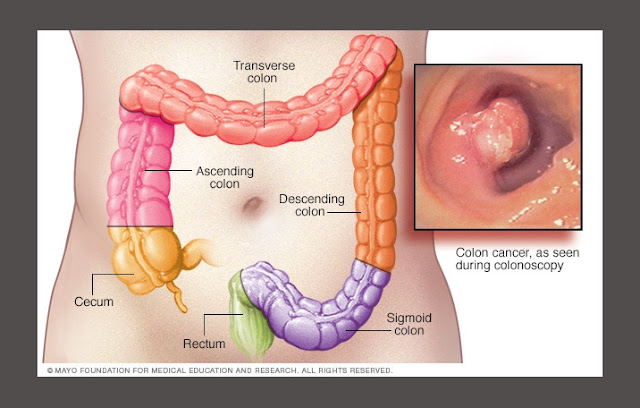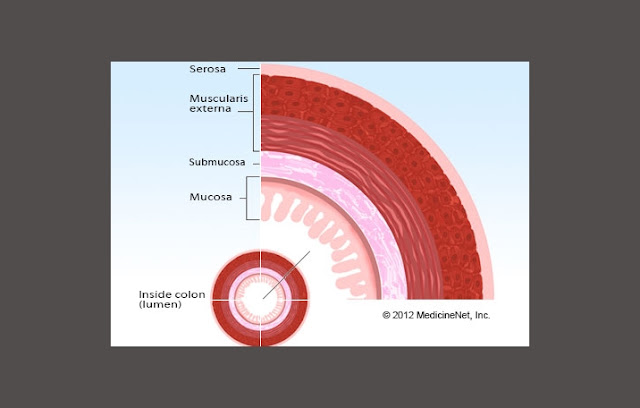A. UNDERSTANDING THE DEFINITION OF COLON
(LARGE INTESTINE)
Colon is one of the organs of the digestive system
which is a continuation of the small intestine. The large intestine is often
also referred to as colon. The main function of the colon is to perform
absorption of food that are not able to be absorbed in the small intestine,
also absorbs water and salt so that it can regulate the balance of fluids in
the body. The water absorption through the large intestine also plays a role in
shaping the stool consistency (liquid or solid). Colon diameter is about 6 cm
with a length of 1.5 meters. The rest of the food that passes through the colon
will end up at the rectum which is the estuary of the large intestine.
B. THE FUNCTIONS OF COLON (LARGE
INTESTINE)
- Absorbing fluid and salt from foods that have gone through the colon.
- To keep the fluid and electrolyte balance through water absorption in the digestive tract.
- Produce vitamin K which serves as one component of blood clots.
- Protect the gastrointestinal tract from bacterial infections with mucus.
- Balancing the pH of the food by producing an alkaline solution and there are bacteria that produce fat so that the acidity of the food can be neutralized.
- Waste storage and elimination of wastes that are not needed by the body.
C. THE STRUCTURE OF COLON (LARGE
INTESTINE)
The colon wall has a structure similar to most of the
small intestine and other digestive organs. The structure of the colon wall
composed by 4 below (From outside to inside):
1. Serous Layer
The outermost layer is composed of blood vessels,
lymphatics and nerves. Serous layer of the large intestine is in the form of
connective tissue that is covered by visceral peritoneum. Serous layer has
small cavities where the discharge of serous fluid issued, this fluid serves as
a lubricant for muscle movement.
2. Muscle
Layer
Muscle layer of the Colon is a layer of smooth muscle
that works involuntary. There are two types of muscle fibers, the longitudinal
muscle fibers (lengthwise) and circular muscle fibers (circular). The
combination of both types of muscle contraction will produce intestinal
peristalsis which serves to break down the food and took it to the next
digestive organ.
3. Submucosa Layer
Layer that composed by connective tissue containing blood
vessels, lymphatics, nerves and mucous glands. The blood vessels in the
submucosal layer of the colon plays an important role in passing the food and
nutrition.
4. Mucosa Layer
Mucous layer prepared by simple epithelial cells and thin
connective tissue. The mucosal lining had goblet cells that can produce mucus.
Mucus is a secretion from glands throughout the large intestine. The production
of this layer which influenced by the hormone secretin and enterocrinin is
often also called intestinal juice.
D. PARTS OF COLON (LARGE INTESTINE)
Colon can be divided into six main parts, These part
is difficult to distinguish histologically. Supply of nutrients and oxygen of
large intestine derived from the superior mesenteric artery (upper) and
inferior mesenteric artery (bottom).
6 part of the small intestine are:
 |
| PARTS OF COLON |
1. cecum
Cecum or caecum is the first part of the colon that
is shaped like a pouch. It could be said that the cecum is a combination of the
last part of the small intestine (ileum) with the first part of the colon.
Cecum has a length of about 7 cm. The main function of this bag is to carry out
the absorption of nutrients that are not absorbed in the small intestine.
2. Ascending
colon
Ascending colon is a vertical-shaped colon that extends
upwards starting from the bottom of the abdomen (right) to the liver. Ascending
colon is the initial part of the colon. The main function of the ascending
colon is to absorb food that has not been absorbed in the small intestine.
3. Transverse
Color
Transverse Color is a continuation of the ascending
colon with a horizontal shape. Transverse Color attached to the stomach, which
served to attach the tissue is called omental adhesions tissue. The main
function of the Transverse Color is to enhance the absorption of nutrients from
food and helps solidify the stool.
4. descending
colon
The descending colon is a continuation of Transverse
colon moving downward and ends in the sigmoid colon. Descending colon serves as
a temporary shelter of tool and help adjust the density of faeces.
5. Sigmoid
Colon
Sigmoid colon is contiuation of the descending colon,
short sized and shaped like the letter S. The sigmoid colon is located on the
lower left side of the abdomen. Sigmoid colon has a strong muscle tissue so
that it can perform its function to push the stool toward the rectum.
6. rectum
The rectum is the last part of the Large intestine
with thick mucous layer structure and a lots blood vessels. The main function
of the rectum is as a temporary storage of the stool which will secreted out
through the anus. Stacking stool will stimulate the nerves found in the rectum
to defecate (BAB).



